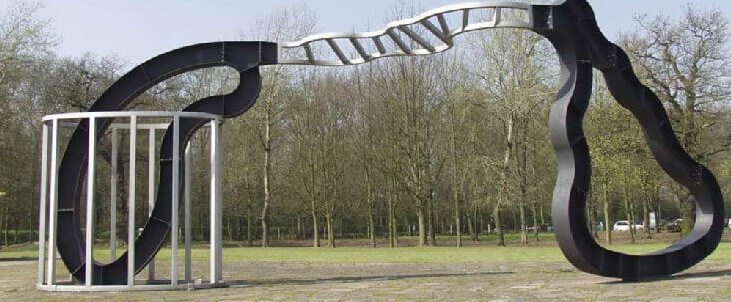What do we really think of campus art?
How an oversized white traffic cone with neon-blue lights promotes Buddhist thoughtfulness is anyone’s guess. Equally perplexing is that it was meant as a symbol for a university’s ambition to become world leading. Yet with time the time they improve student experience and become part of the Warwick’s distinct personality.
Warwick campus presents a host of bizarre sculptures, hoping to evoke reactions from passers-by. At first they grate, personifying the eccentricity Warwick sometimes radiates. Later they remind us that there is a world outside the exam room, as the final term becomes overwhelming. Yet throughout your time at Warwick they provide something contrasting to the monochrome grey landscape of campus life.
Sculpture acts as a universally accessible art form, prompting an individual reaction
I spoke with the arts curator for the Mead Gallery, Sarah Shalgosky, who explained that the sculptures form part of Warwick’s ambition to open students’ minds to new ideas. “What art triggers in your brain is yours. It is about letting students find their voice. Abstract art helps by not giving answers, but rather raising questions for people to ponder upon.” She often asks “what does the art mean to you?” prompting interesting and imaginative reflections on colours and shapes. Sculpture acts as a universally accessible art form, prompting an individual reaction.

Sarah claims that the imaginatively named 3B Series 1, located by Rootes accommodation, is “instantly recognised as a playground.” Or at least, when local children pass by on the Warwick Sculpture Trail, this is how they receive it. Its striking red colour also makes it a beacon for students, who have reportedly been spotted climbing it both after circling and in the yearly zombie run.
It keeps the 60s vibe going on around campus
Accounting and Finance finalist Joanna Jakubowska revealed that she too thought it was a playground when she first saw it, adding “It keeps the 60s vibe going on around campus.” Costing only £1500 in 1968, it is now one of the few sculptures nationally to have a Grade II National Heritage listing.
Overall there is an inevitable mixed reaction to campus art as our survey has shown. Some students go far beyond merely positively responding, sending distressed emails to Sarah when the windmill on the hill behind Nigel Thrift’s house disappeared whilst it was away for repairs.
the lonely twirling shark tooth outside the Warwick Arts Centre becomes a dear reminder of times old
With just a hint of irony, Grace Khoo, first year EPAIS says that the Koan “looks like it was made in China, but it successfully acts as the symbol for the university.” One Warwick student said “It makes me feel like I’m part of the Warwick student body. I think I like it purely because of its ‘Warwickness’”. Let’s Not Be Stupid is meant to represent an abstract, shape-shifting drawing in space, complimenting a once-inflatable student union building. A few students have drawn wry links between 3B Series 1 and Pop; for some, it is Rootes’ lucky charm.
A reluctant fondness is perhaps how to best describe student’s feelings for these quirky objects. They are not the most loved at times, and sometimes brought up as an example of Warwick’s grandstanding, but they will be remembered long after students have drifted away, silently guarding the next generation. For what it is, the lonely twirling shark tooth outside the Warwick Arts Centre becomes a dear reminder of times old, in front of which nostalgic graduates will pose, earning it’s presence on many a mantel piece around the world.

Comments (1)
*complementing*